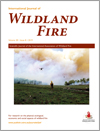International Journal of Wildland Fire
Volume 28
Number 8 2019
A review and synthesis of existing data, research and historical investigations related to wildland firefighter entrapments in the United States are presented. Specific topics discussed include a critique of the data collection and storage procedures following entrapments, historical and geographical trends and a summary of research needs.
Fire behaviour and smoke models provide smoke information for managers to assess fire impacts and develop mitigation plans. This review paper describes the modelling efforts performed to understand modelling issues and data needs. The results are used to support the design of field campaigns such as the Fire and Smoke Model Evaluation Experiment (FASMEE), which conduct comprehensive measurements of fuels, fire behaviour, emission, smoke and weather, and the development of the next-generation smoke research and forecasting systems.
Prescribed fire managers face increasing challenges in meeting extensive area-treated objectives. Amid discussion of the trade-offs involved with relaxing burn weather parameters, our analysis revealed the potential for small changes to result in larger expansions of the opportunities to burn by a factor of 2. These expansions were mostly driven by relaxing the upper limits on mixing height in the growing season and on transport wind in the dormant season.
Fire in organic peat soils is often in the form of flameless and slow-spread smouldering, different from conventional flaming wildfires. This work explores whether a flame can be piloted above the peat soil under external heating, and then spread quickly over a peatland surface to rapidly increase the scale of the peat fire.
As for moisture content or leaf thickness, mono-, sesqui- and diterpenes (especially the highly concentrated compounds) were involved to varying degrees, sometimes in opposite ways, in both leaf and litter flammability of different species used in the WUI. Their diversity and content differed among species but not between fuel types.
We used an autoregressive distributed lag model, a common econometric analysis, to examine the climate correlates of area burned in the grasslands of Xilingol, China. Using mean monthly climate inputs from 2001 to 2014, the model identified temperature as an important influence on area burned.





